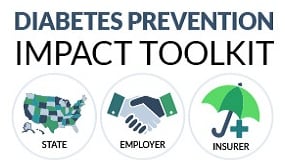Calculate Benefits and Costs
Cost effectiveness – and potential cost savings – are factors to think about when considering the impact of offering the National DPP lifestyle change program. CDC and the American Medical Association (AMA) have developed cost calculator tools to help employers, insurers, and other stakeholders estimate potential return on investment (ROI) and other cost and health outcome measures associated with offering the National DPP lifestyle change program to employees, beneficiaries, or members.
While the datasets and assumptions supporting the AMA and CDC cost calculators are different, both tools can help organizations forecast the benefits of offering the National DPP.
CDC Diabetes Prevention IMPACT TOOLKIT
Just how much can diabetes prevention programs save? To help employers, insurers, and state health departments weigh the costs and benefits of National DPP lifestyle change programs, CDC has developed the Diabetes Prevention Impact Toolkit. This online tool provides estimates of:
- Total cost of delivering a National DPP or similar lifestyle change program to a covered population
- Total health benefit resulting from the program
- Life years gained and quality-adjusted life years saved
- Cost-effectiveness of the lifestyle change program
- Return on investment, if applicable
Users can get results based on default values for their target population or enter customized values that reflect their own population and program experience. Users can also customize the toolkit’s results to show the most relevant data for their needs. Explore the Diabetes Prevention Impact Toolkit or to learn more about the Impact Toolkit and how to use it, take a look at the help and resources.
AMA DPP Cost Saving Calculator
Use the AMA DPP Cost Saving Calculator to calculate your potential medical cost savings from providing the National DPP as a covered benefit.
By enabling individuals within your population who are at risk for type 2 diabetes to participate in a local or virtual CDC-recognized lifestyle change program, you can help them prevent type 2 diabetes and reduce your organization’s health care spending.
Enter information unique to your population into this calculator to see potential cost savings for your population.
Different cost calculator tools can yield different conclusions because of the data and assumptions underlying their calculations*. Two of the primary factors leading to differences in conclusions generated by these two tools are the estimates of 1) progression from prediabetes to type 2 diabetes; and 2) the reduction in risk provided by lifestyle intervention. The CDC’s assumptions for these estimates are towards the lower ranges modeled after a more nationally representative sample, and the AMA’s assumptions are towards the higher ranges modeled after a more targeted employer representative sample.
While the datasets and assumptions supporting the AMA and CDC cost calculators are different, both tools can help organizations forecast the benefits of offering the National DPP.
*Default values programmed in the AMA Cost Calculator are based on studies referenced in the Assumptions and Methodology [PDF – 118 KB] provided with the tool. Cost estimates in the AMA Cost Calculator are derived from the Khan et al 2017 study using claims data from the Truven Health MarketScan(R) Lab Database (commercially insured population). Default values programmed in the CDC Diabetes Prevention Impact Toolkit are based on numerous studies referenced in the Technical Report [PDF – 1 MB] that accompanies the Toolkit as well as early data from the CDC Diabetes Prevention Recognition Program. Both tools allow for some customization. The Diabetes Prevention Impact Toolkit lets employers and insurers customize estimates of program costs, diabetes-related medical costs, and potential return on investment (ROI) using their own employee/member data and assumptions. The AMA Cost Calculator allows health systems, payers and employers to customize anticipated enrollment and completion rates, based on their experiences with other programs, and looks at the potential immediately avoidable spend for those organizations that have high employee/member turnover.

